Imagine a city where the streets are not just lit up at night, but actively working to make your life easier, safer, and more sustainable. A city where streetlights can monitor air quality, reduce traffic congestion, and even help charge your electric car. This is not a distant dream—it’s the reality of smart pole.
smart pole—versatile, intelligent street lighting systems that go beyond basic illumination to support a wide range of applications. From energy-efficient lighting to air quality monitoring, smart poles are revolutionizing how cities function.
what goals are the TECNON Smart Display Smart Light Pole solution to achieve? What does the physical structure of our smart light poles look like, and how do they contribute to smart city development?
Smart Pole?
A smart pole is an advanced street lighting solution that integrates multiple technologies to support various smart city applications. Unlike traditional street lights, which are designed solely for illumination, smart poles serve as multifunctional hubs that can house sensors, cameras, pole LED screens, Wi-Fi hotspots, and much more. These poles are equipped with IoT (Internet of Things) capabilities, allowing them to collect, transmit, and analyze data in real-time.

The Functions of Smart Poles
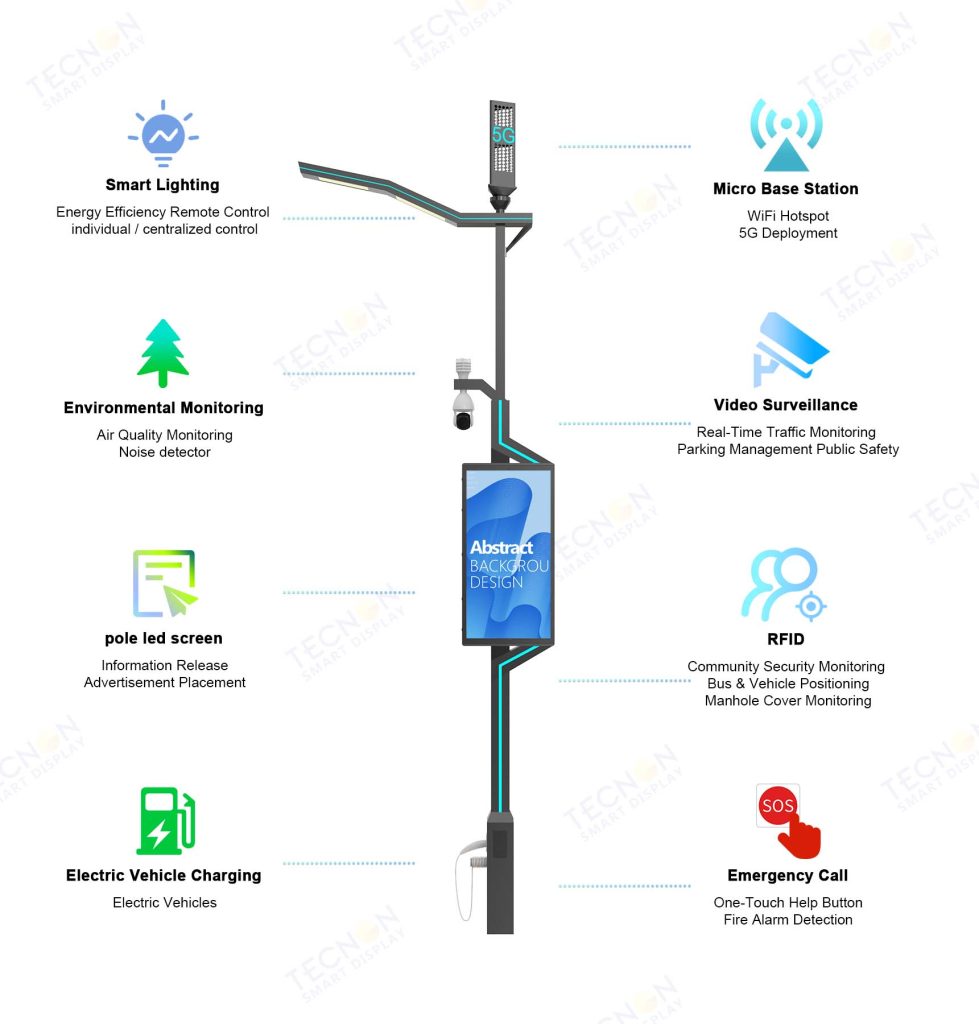
1. Smart Lighting System
The primary function of a intelligent poles is energy-efficient lighting. Using cutting-edge LED technology, these poles provide bright, consistent illumination while reducing energy consumption. The lighting system is adaptive, adjusting its brightness based on environmental factors like time of day or weather conditions. With the ability to remotely control each light source, smart poles can ensure optimal lighting levels at all times.
- Energy Efficiency: Smart poles reduce energy usage by adjusting brightness based on real-time data.
- Remote Control: The lighting can be dimmed or switched off remotely, improving efficiency and cutting costs.
- individual / centralized control:The Jixun smart pole controller allows on-demand switching and dimming of individual lights, with energy-saving management and fault alarm functions.

2. Environmental Monitoring
One of the key benefits of smart poles is their ability to integrate environmental sensors. These sensors can monitor air quality, temperature, humidity, noise levels, and more. Data collected by these sensors is sent to a cloud platform, where it is analyzed and used to inform decisions related to urban planning, pollution control, and public health.
- Real-Time Data Collection: Sensors track environmental factors like PM2.5, noise, temperature, and humidity.
- Air Quality Monitoring: Intelligent poles can detect harmful pollutants and send alerts to authorities for quick action.

3. Traffic and Parking Management
Smart light pole play a crucial role in improving traffic flow and parking management in urban areas. With integrated sensors and cameras, smart poles can monitor traffic patterns, detect accidents, and manage parking availability. This leads to reduced congestion, fewer accidents, and lower emissions.
- Real-Time Traffic Monitoring: Smart poles help in managing traffic flow by providing real-time data on congestion.
- Parking Management: Sensors integrated into smart poles can help drivers find available parking spaces, reducing search time and traffic.
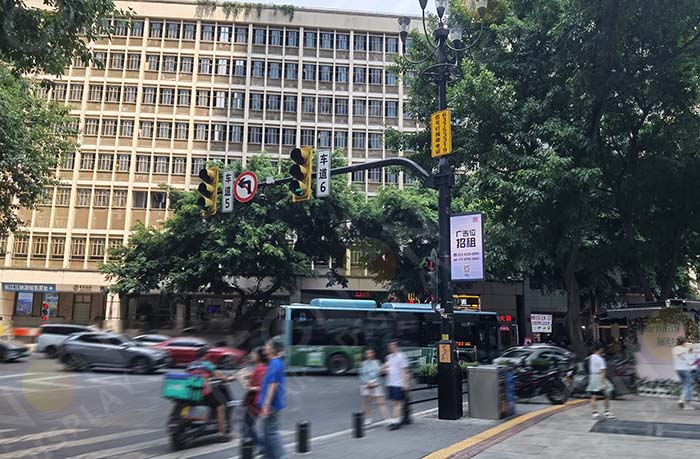
4. Public Safety and Surveillance
Security is an important part of smart cities, and smart light pole can help enhance public safety. These poles can be fitted with cameras to monitor public spaces, detect suspicious activities, and help law enforcement with real-time surveillance.
- Video Surveillance: Cameras provide continuous monitoring of public areas to detect crime or unusual behavior.
- Traffic Enforcement: Cameras can monitor illegal driving behaviors, such as speeding or illegal parking.
- Security Alerts: Real-time alerts can be sent to the police or security personnel in case of emergencies.

5. Communication and Information Dissemination
Another valuable feature of smart poles is their ability to act as communication hubs. Integrated LED screens can display important public information, advertisements, or news updates.By offering dynamic, visible communication, they play a key role in keeping citizens informed and engaged.
- Information Release
The pole led screens can display important public information, such as government notices, emergency alerts, event schedules, and traffic update.
- Advertisement Placement
Smart poles offer a platform for targeted digital advertising. Businesses can place ads on the screens in high-traffic areas, allowing for effective marketing while generating revenue for the city.

6. Micro Base Station
- Embedded WiFi Hotspot: Smart poles provide WiFi connectivity in public spaces, offering free internet access to residents and visitors.
- 5G Deployment: The intelligent light pole doubles as a miniaturized 5G base station, helping to accelerate 5G network expansion by utilizing streetlight poles throughout the city.

7. Electric Vehicle Charging
As cities move toward more sustainable transportation, smart poles can serve as charging stations for electric vehicles (EVs). With built-in EV chargers, smart poles provide convenient charging points for residents and visitors, encouraging the adoption of eco-friendly vehicles.
- EV Charging Stations: Smart poles can house electric vehicle chargers, supporting the transition to electric transportation.
- Sustainable Infrastructure: This promotes clean energy and reduces reliance on fossil fuels.

8. RFID
- Special Crowd Monitoring: Track and monitor specific groups for security or safety purposes.
- Manhole Cover Monitoring: Ensure manhole covers are intact and secure, preventing accidents.
- Community Security Monitoring: Monitor community areas for safety and potential security threats.
- Municipal Facilities Monitoring: Keep track of the status and condition of essential municipal infrastructure.
- Bus & Vehicle Positioning: Use RFID to track the location of buses and other vehicles in real time.

9. Emergency Call
- Monitoring Center Connection: Extend communication to the monitoring center for immediate assistance.
- Active Broadcasting: Enable two-way communication between the monitoring center and the field through live broadcasts.
- One-Touch Help Button: A simple button for emergency calls, providing fast access to help.
- Fire Alarm Detection: Detect and respond to fire-related incidents through various sensors:
– Spray Mist Detection
– Vehicle Exhaust Detection
– Gas Leak Detection

Our Five-dimensional Service System
To help cities fully leverage the potential of smart poles, we offer a comprehensive five-dimensional service system. This system can ensure end-to-end solutions for urban infrastructure development, from product design to maintenance.
1. Product Development:
We work closely with cities and urban planners to design custom smart poles that meet their specific needs. Whether it’s lighting, environmental monitoring, or communication, our poles are built to integrate multiple technologies seamlessly.
2. Manufacturing:
Our state-of-the-art manufacturing facility ensures that each smart light pole meets the highest quality standards. From the choice of materials to the assembly process, we ensure durability and long-lasting performance.
3. Lighting Design:
We offer expert lighting design services, ensuring that the smart lighting system provides optimal visibility and energy efficiency. Our lighting solutions are scalable and adaptable to different urban environments.
4. Project Implementation:
We manage the entire implementation process, from site surveys to installation. Our team ensures that each smart pole is installed correctly and integrated with the city’s existing infrastructure.
5.Service and Maintenance:
We provide ongoing support and maintenance for all smart poles. This includes regular checks, software updates, and troubleshooting to ensure that the poles remain functional and efficient throughout their lifespan.
System Architecture
1. Perception Output Devices: These are the front-end devices responsible for collecting data and outputting it. They include lighting, sensors, cameras, audio systems, LED screens, and other equipment.
2. Communication Control Equipment: This equipment manages data communication and controls the perception devices. It includes smart streetlight gateways, RTUs, and data acquisition instruments, which are chosen based on the environment and business needs.
3. Data Command Flow: The communication control devices are connected to perception devices using interfaces like RS232 or RS485. These devices collect data and control equipment, while the communication control unit transmits data to the platform via 5G/4G or wired connections for real-time processing.
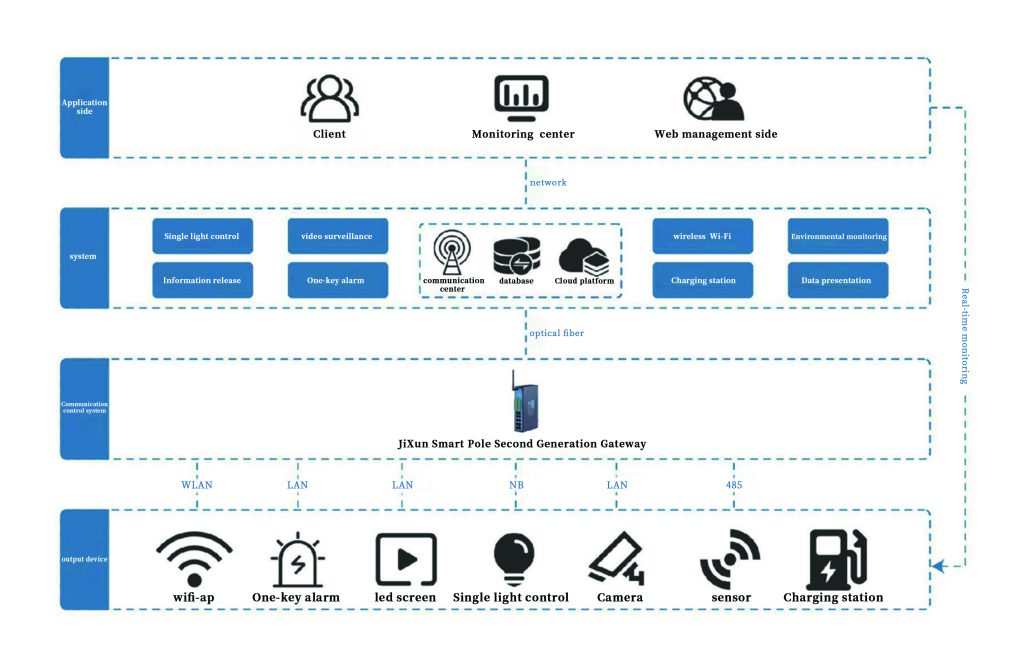
Smart pole for smart cities
As cities continue to evolve, the need for smarter infrastructure will grow. Smart poles are an essential part of this transformation, providing the foundation for a more efficient, sustainable, and connected urban environment. By integrating lighting, environmental monitoring, traffic management, security, and communication into a single solution, smart poles enable cities to address a wide range of challenges.
The future of smart cities is bright, and smart poles are at the forefront of this revolution. With our five-dimensional service system, we will help cities unlock the full potential of smart pole technology.

Cases
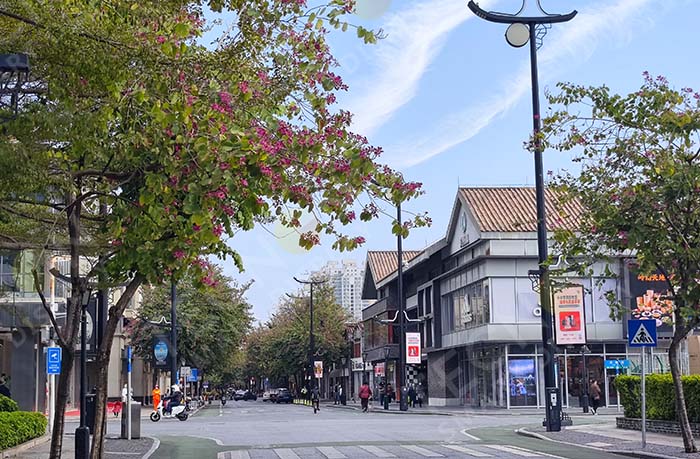
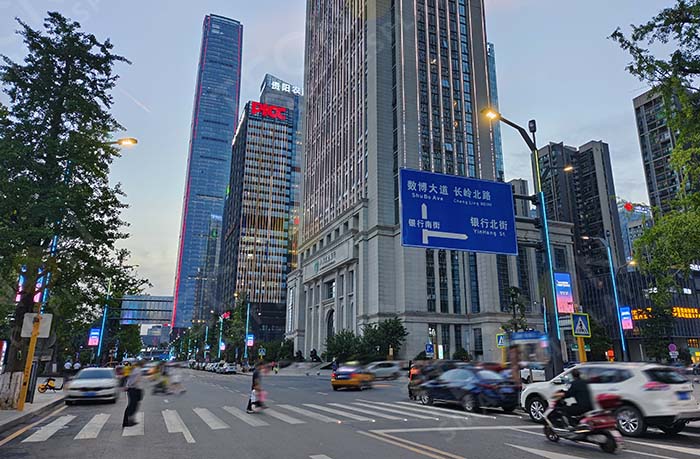
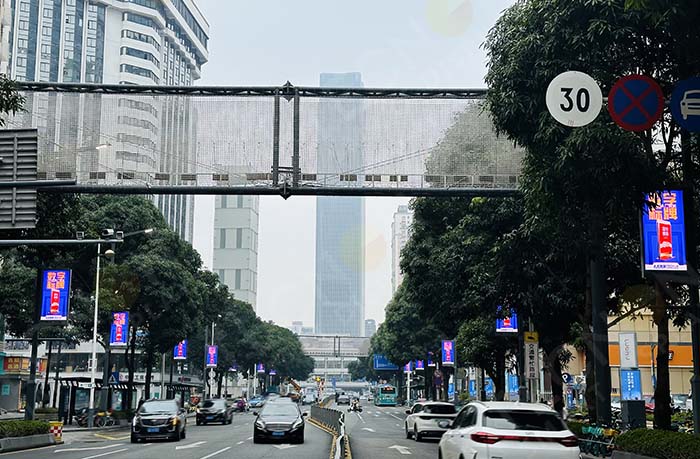
Final Words
If you’re ready to transform your city with our smart pole solution, we’re here to partner with you. Contact us today to learn how our innovative solutions can bring your smart city vision to life.
 Tecnon Smart Display Technology Shenzhen Co., Ltd.
Tecnon Smart Display Technology Shenzhen Co., Ltd.